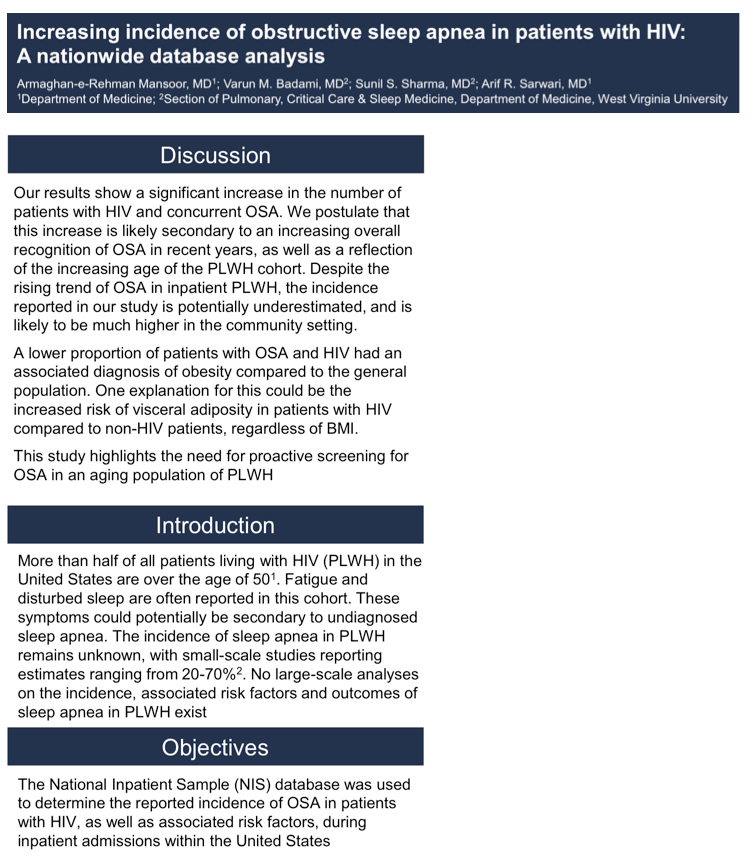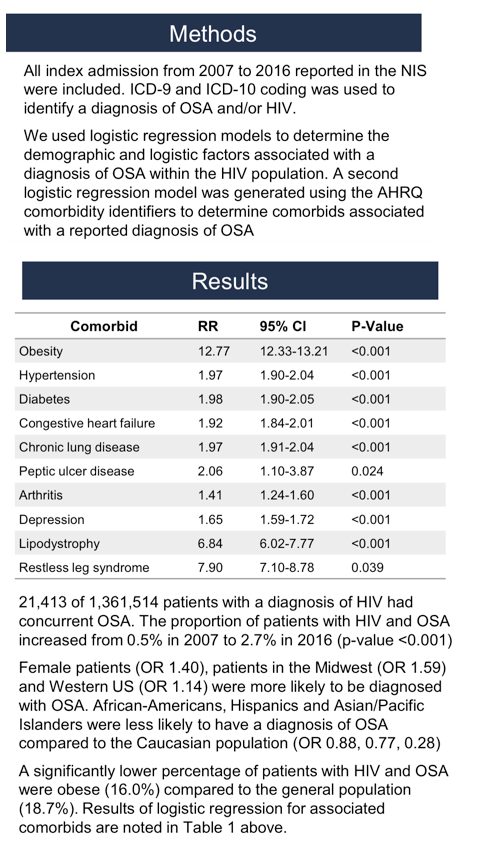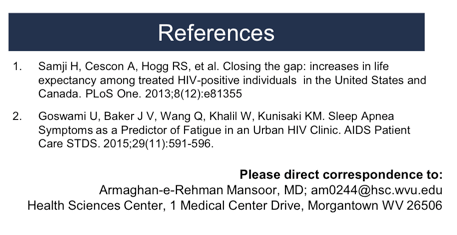 |
 |
 |
| |
Increasing incidence of obstructive sleep apnea in patients with
HIV: A nationwide database analysis
Sleep Apnea Rate Rises 5-Fold Among Hospital Inpatients With HIV
|
| |
| |
IDWeek 2020, October 22-25, 2020
Mark Mascolini
Incidence of obstructive sleep apnea among hospital inpatients with HIV vaulted from 0.5% in 2007 to 2.7% in 2016, according to a US national database analysis [1]. Researchers from West Virginia University believe the jump may reflect aging of the HIV population and increasing awareness of sleep apnea in the general population.
Obstructive sleep apnea can lead to hypertension, cardiovascular disease, diabetes, liver problems, and complications with medications and surgery [2]. As people with HIV grow older, they tend to report fatigue and disturbed sleep more frequently. The West Virginia University team wondered if these reports could reflect rising incidence of obstructive sleep apnea in people with HIV. They noted that until now only small studies have explored sleep apnea in HIV groups, reporting rates running from 20% to 70% [3]. In 11 international studies published between 1993 and 2013, obstructive sleep apnea prevalence in the general population averaged 22% in men and 17% in women [4].
The new study used the National Inpatient Sample database to chart obstructive sleep apnea incidence and related risk factors in inpatient admissions across the United States. Appraising all recorded hospital admissions from 2007 through 2016, the researchers used ICD-9 and ICD-10 codes to identify diagnoses of obstructive sleep apnea and HIV. They used logistic regression to determine factors associated with a sleep apnea diagnosis in people with HIV. A second logistic regression model determined comorbid conditions associated with sleep apnea in the HIV group.
Overall, 21,413 of 1,361,514 inpatients (1.6%) had concurrent diagnoses of HIV and obstructive sleep apnea. The proportion of HIV-positive people with sleep apnea rose from 0.5% in 2007 to 2.7% in 2016 (P < 0.001). (The researchers did not adjust this overall analysis for age or other variables.) Female patients with HIV had 40% higher odds of a sleep apnea diagnosis than males with HIV, and sleep apnea proved more likely in the US Midwest (odds ratio [OR] 1.69) and the West (OR 1.14). Compared with whites, African Americans (OR 0.88), Hispanics (OR 0.77), and Asian/Pacific Islanders (OR 0.28) had lower odds of a sleep apnea diagnosis.
Compared with sleep apnea patients in the general population, a lower proportion of people with HIV and sleep apnea were obese (16.0% versus 18.7%). But logistic regression limited to people with HIV singled out obesity as the leading comorbidity risk factor for sleep apnea in the whole study population (RR 12.77, 95% confidence interval [CI] 12.33 to 13.21, P < 0.001). Other associated comorbidities were hypertension (RR 1.97, 95% CI 1.90 to 2.04, P < 0.001), diabetes (RR 1.98, 95% CI 1.90 to 2.05, P < 0.001), congestive heart failure (RR 1.92, 95% CI 1.84 to 2.01, P < 0.001), chronic lung disease (RR 1.97, 95% CI 1.91 to 2.04, P < 0.001), peptic ulcer disease (RR 2.06, 95% CI 1.10 to 3.87, P = 0.024), arthritis (RR 1.41, 95% CI 1.24 to 1.60, P < 0.001), depression (RR 1.65, 95% CI 1.59 to 1.72, P < 0.001), lipodystrophy (RR 6.84, 95% CI 6.02 to 7.77, P < 0.001), and restless leg syndrome (RR 7.90, 95% CI 7.10 to 8.78, P = 0.039).
The West Virginia University researchers speculated that the rising rate of obstructive sleep apnea among people with HIV may partly reflect growing awareness of this condition in the United States as well as aging of the US HIV population. They suggested that the sleep apnea rate reported in their analysis may underestimate true incidence in the HIV community, that is, in people not admitted to the hospital. The research team proposed that the lower obesity rate in HIV patients with apnea than in the general population with apnea could reflect the higher risk of visceral adiposity in people with HIV, regardless of body mass index (which determines whether a person is obese).
The authors advocate proactive screening for obstructive sleep apnea in the aging HIV population.
References
1. Mansoor A, Badami VM, Sharma S, Sarwari AI. Increasing incidence of obstructive sleep apnea in patients with HIV: A nationwide database analysis. IDWeek 2020, October 22-25, 2020. Abstract 922.
2. Mayo Clinic. Sleep apnea.
https://www.mayoclinic.org/diseases-conditions/sleep-apnea/symptoms-causes/syc-20377631
3. Goswami U, Baker JV, Wang Q, Khalil W, Kunisaki KM. Sleep apnea symptoms as a predictor of fatigue in an urban HIV clinic. AIDS Patient Care STDS. 2015;29:591-596. doi: 10.1089/apc.2015.0079.
4. Franklin KA, Lindberg E. Obstructive sleep apnea is a common disorder in the population-a review on the epidemiology of sleep apnea. J Thorac Dis. 2015;7:1311-1322. doi: 10.3978/j.issn.2072-1439.2015.06.11.



|
| |
|
 |
 |
|
|